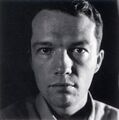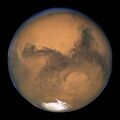Template:Selected anniversaries/August 27: Difference between revisions
No edit summary |
No edit summary |
||
| (8 intermediate revisions by the same user not shown) | |||
| Line 5: | Line 5: | ||
||1783: The first experimental hydrogen-filled balloon left the Champs de Mars, Paris, unmanned, and reached 900-m altitude. Under the auspices of the French Academy of Sciences, Jacques A.C. Charles sent up a 13-ft (4-m) diameter hydrogen- filled balloon of rubber- coated silk. One of the spectators was the American ambassador to France, Benjamin Franklin. The gas had been manufactured, beginning on 23 Aug 1783, by pouring 225-kg of sulphuric acid over half a ton of scrap-iron. Able to lift about 9-kg, it traveled 24-km in about 45 minutes. The balloon descended close to the little village of Gonesse, where frightened local farmers attacked it with pick axes and spades, leaving only torn remains. | ||1783: The first experimental hydrogen-filled balloon left the Champs de Mars, Paris, unmanned, and reached 900-m altitude. Under the auspices of the French Academy of Sciences, Jacques A.C. Charles sent up a 13-ft (4-m) diameter hydrogen- filled balloon of rubber- coated silk. One of the spectators was the American ambassador to France, Benjamin Franklin. The gas had been manufactured, beginning on 23 Aug 1783, by pouring 225-kg of sulphuric acid over half a ton of scrap-iron. Able to lift about 9-kg, it traveled 24-km in about 45 minutes. The balloon descended close to the little village of Gonesse, where frightened local farmers attacked it with pick axes and spades, leaving only torn remains. | ||
||1784: James Tytler made the first balloon ascent in Britain in a hot-air balloon at | File:James_Tytler.jpg|link=James Tytler|1784: Apothecary and editor [[James Tytler (nonfiction)|James Tytler]] made the first balloon ascent in Britain in a hot-air balloon at Edinburgh, Scotland. Before a small number of onlookers, the balloon rose to 350 feet in the air, travelled half a mile, and landed in Restalrig village. | ||
||1850: Augusto Righi born ... physicist and a pioneer in the study of electromagnetism. Pic. | ||1850: Augusto Righi born ... physicist and a pioneer in the study of electromagnetism. Pic. | ||
| Line 39: | Line 39: | ||
||1910: Giovanni Schiaparelli dies ... astronomer and historian. Pic. | ||1910: Giovanni Schiaparelli dies ... astronomer and historian. Pic. | ||
||1913: Chemist Martin Kaymen born ... together with Sam Ruben, co-discovered the synthesis of the isotope carbon-14 on February 27, 1940, at the University of California Radiation Laboratory, Berkeley. Pic search | ||1913: Chemist Martin Kaymen born ... together with Sam Ruben, co-discovered the synthesis of the isotope carbon-14 on February 27, 1940, at the University of California Radiation Laboratory, Berkeley. Pic search. | ||
File:Norman F. Ramsey Jr.jpg|link=Norman Foster Ramsey Jr. (nonfiction)|1915: Physicist [[Norman Foster Ramsey Jr. (nonfiction)|Norman Foster Ramsey Jr.]] born. He will be awarded the 1989 Nobel Prize in Physics for the invention of the separated oscillatory field method, which will have important applications in the construction of atomic clocks. | File:Norman F. Ramsey Jr.jpg|link=Norman Foster Ramsey Jr. (nonfiction)|1915: Physicist [[Norman Foster Ramsey Jr. (nonfiction)|Norman Foster Ramsey Jr.]] born. He will be awarded the 1989 Nobel Prize in Physics for the invention of the separated oscillatory field method, which will have important applications in the construction of atomic clocks. | ||
| Line 46: | Line 46: | ||
||1924: William Bayliss dies ... physiologist who, in 1902 co-discovered the first hormone (with the British physiologist Ernest H. Starling). They found a certain chemical substance is secreted when food comes into contact with part of the small intestine. This chemical substance, which they named secretin, upon being carried by the blood to the pancreas, stimulates the secretion of pancreatic juice, the most important of the digestive juices. They coined the word “hormone” based on a Greek word for “to set in motion.” Bayliss also studied the use of saline injections to counteract shock during surgery. He proposed the use of gum-saline injections for wound shock to saved many lives of wounded soldiers in WW I. Pic. | ||1924: William Bayliss dies ... physiologist who, in 1902 co-discovered the first hormone (with the British physiologist Ernest H. Starling). They found a certain chemical substance is secreted when food comes into contact with part of the small intestine. This chemical substance, which they named secretin, upon being carried by the blood to the pancreas, stimulates the secretion of pancreatic juice, the most important of the digestive juices. They coined the word “hormone” based on a Greek word for “to set in motion.” Bayliss also studied the use of saline injections to counteract shock during surgery. He proposed the use of gum-saline injections for wound shock to saved many lives of wounded soldiers in WW I. Pic. | ||
||1926: Kristen Nygaard born ... computer scientist and academic. Pic. | ||1926: Kristen Nygaard born ... computer scientist and academic. Pic. | ||
| Line 55: | Line 53: | ||
||1929: Herman Potočnik dies ... rocket engineer and pioneer of cosmonautics (astronautics). He is chiefly remembered for his work addressing the long-term human habitation of space. Pic. | ||1929: Herman Potočnik dies ... rocket engineer and pioneer of cosmonautics (astronautics). He is chiefly remembered for his work addressing the long-term human habitation of space. Pic. | ||
||1939: Östen Mäkitalo born ... engineer and academic dies ... Nordic mobile. Pic search. | |||
||1939: Östen Mäkitalo born ... engineer and academic dies ... Nordic mobile. Pic search | |||
||1939: First flight of the turbojet-powered Heinkel He 178, the world's first jet aircraft. | ||1939: First flight of the turbojet-powered Heinkel He 178, the world's first jet aircraft. | ||
||1945: Jan Sloot dies ... computer scientist and electronics technician. Pic search | ||1945: Jan Sloot dies ... computer scientist and electronics technician. Pic search. | ||
||1950: The BBC transmitted in Britain the first cross-Channel live television programme by microwave relay links celebrated the centenerary of the first cross-Channel telegraph by submarine cable. Although the working range for outside broadcast units of the time had been just 25 miles (40 km), a greater distance was made possible using a relay of microwave signals between five portable radio-link stations, able to send and receive microwave signals. Thus the signal was relayed 95-miles (153 km) for the two-hour programme originating in Calais, in Northern France, to London. The show presented the town of Calais "en fete", with a torchlight procession, dancing and a firework display from the Place de l'Hotel de Ville. | ||1950: The BBC transmitted in Britain the first cross-Channel live television programme by microwave relay links celebrated the centenerary of the first cross-Channel telegraph by submarine cable. Although the working range for outside broadcast units of the time had been just 25 miles (40 km), a greater distance was made possible using a relay of microwave signals between five portable radio-link stations, able to send and receive microwave signals. Thus the signal was relayed 95-miles (153 km) for the two-hour programme originating in Calais, in Northern France, to London. The show presented the town of Calais "en fete", with a torchlight procession, dancing and a firework display from the Place de l'Hotel de Ville. | ||
| Line 73: | Line 69: | ||
||1962: The Mariner 2 unmanned space mission is launched to Venus by NASA. | ||1962: The Mariner 2 unmanned space mission is launched to Venus by NASA. | ||
||1977: Gersh Budker dies ... physicist and academic, specialized in nuclear physics and accelerator physics. Pic search | ||1977: Gersh Budker dies ... physicist and academic, specialized in nuclear physics and accelerator physics. Pic search. | ||
||1988: John Francis Riordan dies ... mathematician and the author of major early works in combinatorics, particularly Introduction to Combinatorial Analysis and Combinatorial Identities. Pic, book cover: https://www.amazon.com/Introduction-Combinatorial-Analysis-Dover-Mathematics/dp/0486425363 | ||1988: John Francis Riordan dies ... mathematician and the author of major early works in combinatorics, particularly Introduction to Combinatorial Analysis and Combinatorial Identities. Pic, book cover: https://www.amazon.com/Introduction-Combinatorial-Analysis-Dover-Mathematics/dp/0486425363 | ||
| Line 84: | Line 80: | ||
File:Dennis_Paulson_of_Mars.jpg|link=Dennis Paulson of Mars|2017: ''[[Dennis Paulson of Mars]]'' wins Pulitzer Prize for Best Reality Television Show. | File:Dennis_Paulson_of_Mars.jpg|link=Dennis Paulson of Mars|2017: ''[[Dennis Paulson of Mars]]'' wins Pulitzer Prize for Best Reality Television Show. | ||
</gallery> | </gallery> | ||
Latest revision as of 13:25, 7 February 2022
1784: Apothecary and editor James Tytler made the first balloon ascent in Britain in a hot-air balloon at Edinburgh, Scotland. Before a small number of onlookers, the balloon rose to 350 feet in the air, travelled half a mile, and landed in Restalrig village.
1858: Mathematician Giuseppe Peano born. He will do pioneering work in mathematical logic and set theory.
1915: Physicist Norman Foster Ramsey Jr. born. He will be awarded the 1989 Nobel Prize in Physics for the invention of the separated oscillatory field method, which will have important applications in the construction of atomic clocks.
1926: Chemist and composer George Brecht born. He will be a conceptual artist and avant-garde composer, as well as a professional chemist who will work as a consultant for companies including Pfizer, Johnson & Johnson, and Mobil Oil.
2003: Mars makes its closest approach to Earth in nearly 60,000 years, passing 34,646,418 miles (55,758,005 km) distant.
2017: Dennis Paulson of Mars wins Pulitzer Prize for Best Reality Television Show.





